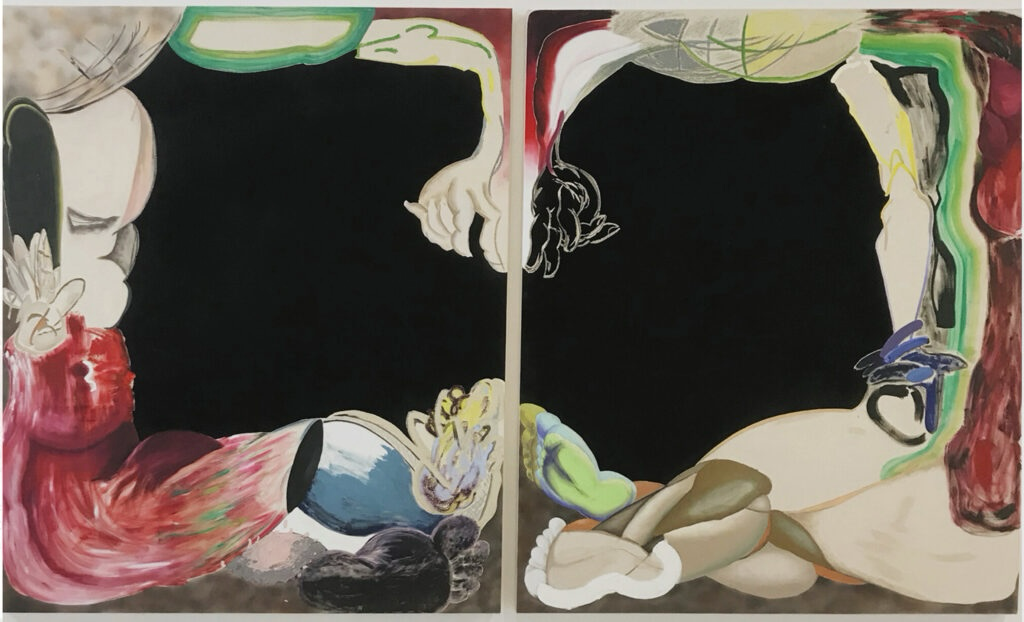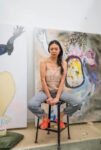
Pui Tiffany Chow
Hong Kong, 1987- (active America)
Is It Inside, Is It Outside, 2020
Acrylic, charcoal, flashe paint, oil, spray paint and suede-Tex flocking on canvas
Courtesy of the artist

Tiffany Chow in her studio
COMMENTS
Artist and educator based in Los Angeles.
Pui Tiffany Chow (b. Hong Kong) immigrated to the US after the Handover of Hong Kong from the British government and now lives and works in Los Angeles. Through a practice centered on drawing and painting, Pui explores abstraction of familiar motifs such as the female body through the distortion of color and form. Her work is a pastiche of different modes, feelings, and approaches - referencing and questioning Western painting traditions.
Through pointed art historical references, Chow’s paintings examine the female form and the capacity for the canvas to stage them. Chow synthesizes Eastern and Western touchstones of visual culture throughout the ages, from Renaissance frescoes to popular Disney and Japanese animation. Traditional Chinese artistic philosophy considers emptiness to be balancing, and Chow employs this theory by omitting dimensional space within the canvas. Beyond the figurative elements in her work, Chow allows only raw linen or black voids rendered with dramatically light absorbing Black 3.0 paint. This type of formation can also be traced back to Henri Matisse’s 1905 painting Le Bonheur de Vivre in which entirely independent motifs are arranged to form a complete composition. In Chow’s work, the figures are similarly self-contained, like captivating performers on an empty proscenium stage.
In contrast to the dainty objects of desire in historic masterworks by male artists, Chow’s female figures are massively obtrusive and alien, barely contained by the confines of the canvas. The scale of the figures in relationship to the canvas is direct- ly influenced by the anatomy of Jacopo da Pontormo’s c.1528 painting Visitation, yet Chow’s figures are unpredictable, each a stylistic departure from the last. Chow renders her subjects in wide-ranging tones, from acidic yellows to deep and lush maroons, envisioning them as discrete conduits to other paintings, explicitly borrowing gestural devices from painters such as Mary Hellmann, Charline von Heyl and George Baselitz. The multiplicity of references in Chow’s work coalesce classical forms into something queer and abstract, transforming the familiar inti an energetic and disorienting sensation.
https://parkergallery.com/content/1-exhibitions/20-pui-tiffany-chow/press-release_pui-tiffany-chow.pdf
SBMA CURATORIAL LABELS
Chow takes female nudes by male European artists, including Jacopo Pontormo, Antonio Canova, and Jean-Honoré Fragonard, and turns them inside out by reinterpreting them from the perspective of women looking at and desiring other women. In this painting, pairs of hands seem to clasp each other and limbs intertwine like wound yarn. Two points of reference are J.A.D. Ingres’ Grande Odalisque (1814) and Diego Velázquez’s Rockeby Venus (c.1647–1651). The black centers with their negative or empty space are a reference to Chinese painting, which often makes these spaces active. The artist recently wrote, “The painting is a feminist and queer reinterpretation of the European canon of female nudes.” Chow was born in Hong Kong, immigrated to the US, and now lives in Los Angeles.
- Friends and Lovers, 2024
